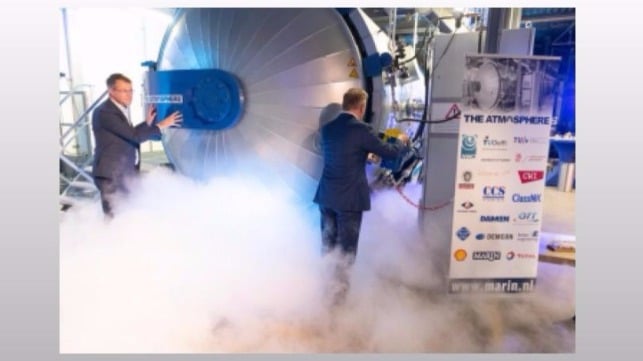New Facility at MARIN Offers More Control Over our Climate

On 19 October 2020 Eppo Bruins, Member of Parliament for the ChristenUnie, officially opened ‘The Atmosphere’, a new facility at MARIN. This autoclave of 15m long and 2.5m diameter offers researchers a new level of control over variables like temperature, pressure, gas composition, humidity and liquids to simulate a wide variety of conditions and to research causes and solutions for the challenges they face.
Multi-purpose testing facility
The Atmosphere is a multi-purpose testing facility used for fundamental research, product development and process optimization. The Atmosphere consists of a precisely controlled environment wherein researchers can control the pressure, temperature and gas composition, to generate a diverse range of conditions. Hannes Bogaert, founding father of The Atmosphere at MARIN: ‘Temperature rise, greenhouse gas, particles, drought, rise in water levels, aerosols … the climate in which we live is changing rapidly without our seeming to have any control over it. The Atmosphere is about taking back control by researching sustainable solutions. With its wide range of control The Atmosphere offers unique possibilities to do so.’
Range of control
The controlled environment is a cylindrical autoclave with a diameter of 2.5 m and a length of 15 m. Liquids and gases can be circulated through the autoclave, and their temperature can be independently controlled in a range from 15°C to 200 °C. The autoclave can be depressurized down to 5 mbar, and pressurized up to 10 bar absolute with a precision of ±2.5 mbar. Gas compositions of nitrogen, helium, sulphur hexafluoride or steam/water vapour can be created with an accuracy of ±1 volume percent. The 76.5 m3 autoclave can accommodate set-ups of up to 8000 kg which can be connected to gas and liquid connections.
24/7 measurements
The autoclave is equipped with 17 inspection glasses with a viewing diameter of 200 mm, multiple flanges for instrumentation, and feedthroughs for shaft drives that can be connected to equipment inside the autoclave. 23 sensors measure the temperature in the liquid and gas. Additionally, the inside of the autoclave is observed with 2 high-speed cameras (up to 100 000 fps) and 4 low-speed cameras (up to 200 fps) The level of liquid inside the set-ups can be measured and controlled within a 0.1 mm accuracy. The facility is fully automated and can perform measurements 24/7.
The Atmosphere is the product of a collaboration between fundamental science and applied research. It has been designed and built within SLING, a research and innovation project of the Netherlands Organization for Scientific Research (NWO). Eppo Bruins: ‘Twenty years ago these were two different worlds, but we managed to evolve them in a multi-disciplinary field. This government had shown its firm conviction that knowledge is the real engine of the future of our country. The budget for science and innovation has grown structurally in the past years, and the government intends to further increase spending through the Growth Fund announced last September.’
Herry Nijhuis, director of NWO domain Applied and Engineering Sciences: ‘The Atmosphere is a unique facility for the Dutch research community. And through the contribution of NWO, it is open to all NWO partners at operational costs only. It is very important that such facilities come to the Netherlands, and the researchers that work with it.’

that matters most
Get the latest maritime news delivered to your inbox daily.
SLING
The Atmosphere's first achievement is SLING. SLING brings the knowledge enabling optimal design and operation of cryogenic fuel tanks. The international shipping organization wants to emit fifty percent less C02 by 2050, and is focusing on natural gas, hydrogen, et cetera. At sea one has to store these fuels in liquid form by extremely cooling them. This requires special fuel tanks that must withstand wave impacts from the sloshing ‘boiling’ fuel in the tank. Scientists in The Atmosphere work with the industry to unravel the complex physics of those wave impacts.
Eric Dehouck, deputy CEO of GTT: ‘The design loads are determined by sloshing model tests. Measurements on board a LNG carrier showed that the results obtained at small scale with model tests are conservative. But we wanted more than that: we want an optimal balance between mechanical strength and thermal efficiency of the fuel tank for each project. The only way is to improve our knowledge on sloshing physics. This is the objective of SLING.’
The products and services herein described in this press release are not endorsed by The Maritime Executive.
